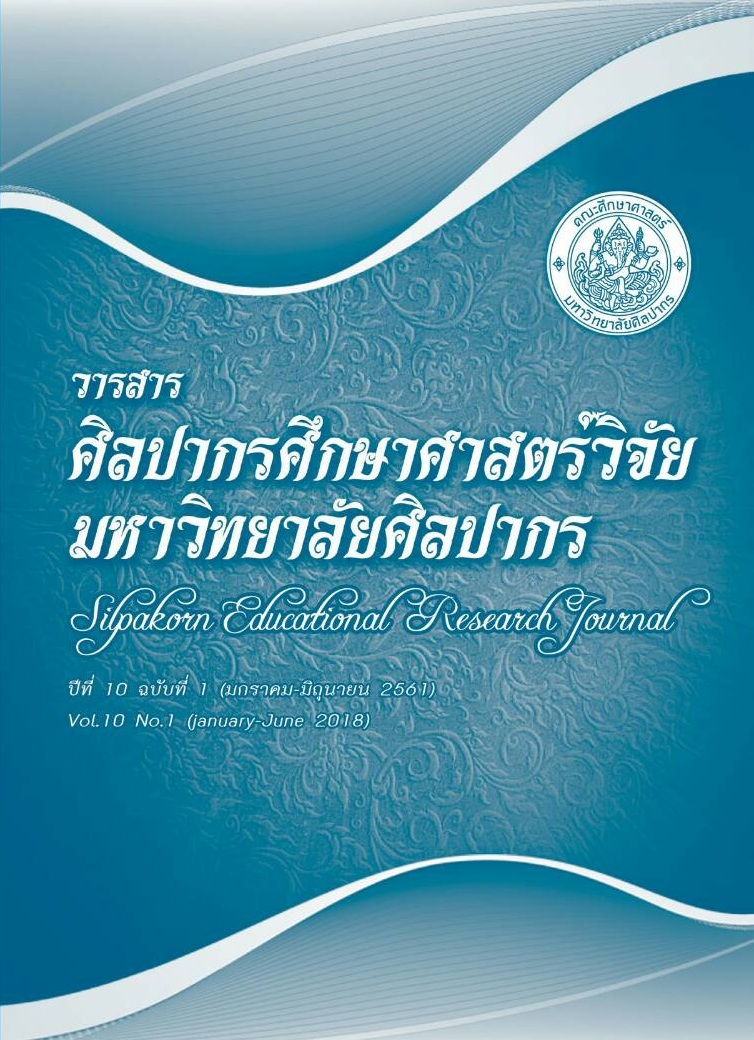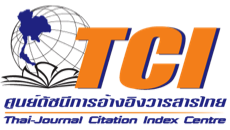การศึกษาสมรรถนะเชิงการเรียนรู้ของนักศึกษาคณะศึกษาศาสตร์ มหาวิทยาลัยศิลปากร (A Study on Learning Competencies of Education Students in Silpakorn University)
คำสำคัญ:
สมรรถนะเชิงการเรียนรู้, ประสบการณ์การเรียนรู้ของนักศึกษา, Learning Competencies, Student Learning Experiencesบทคัดย่อ
บทคัดย่อ
การวิจัยครั้งนี้มีวัตถุประสงค์เพื่อศึกษาสมรรถนะเชิงการเรียนรู้ของนักศึกษาคณะศึกษาศาสตร์ มหาวิทยาลัยศิลปากร ตามการรับรู้ของนักศึกษา โดยใช้วิธีวิจัยเชิงปริมาณและเชิงคุณภาพ กลุ่มตัวอย่างเป็นนักศึกษาคณะศึกษาศาสตร์ มหาวิทยาลัยศิลปากร ปีการศึกษา 2559 การสุ่มกลุ่มตัวอย่างแบ่งเป็น 2 ตอน ตอนที่ 1 จำนวน 318 คน ใช้วิธีสุ่มแบบแบ่งชั้นภูมิ (Stratified Random Sampling) ตอนที่ 2 จำนวน 20 คน เลือกเป็นกรณีตัวอย่างจากนักศึกษา10 วิชาเอก วิชาเอกละ 2 คน เครื่องมือที่ใช้ในการวิจัยเป็นแบบสอบถามสมรรถนะเชิงการเรียนรู้ 1 ฉบับ ค่าความเชื่อมั่นเท่ากับ.90 และแบบสัมภาษณ์ปัจจัยที่ส่งผลต่อสมรรถนะเชิงการเรียนรู้ตามการรับรู้ของนักศึกษา 1 ฉบับ การวิเคราะห์ข้อมูลเชิงปริมาณใช้ค่าร้อยละ (%) ค่าเฉลี่ย () ส่วนเบี่ยงเบนมาตรฐาน (S.D.) การทดสอบค่าที (t-test) และการวิเคราะห์ความแปรปรวนทางเดียว (One-Way ANOVA) การวิเคราะห์ข้อมูลเชิงคุณภาพใช้การวิเคราะห์เนื้อหา
ผลการวิจัยสรุปได้ดังนี้ 1) นักศึกษาคณะศึกษาศาสตร์ มหาวิทยาลัยศิลปากรมีสมรรถนะเชิงการเรียนรู้อยู่ในระดับมาก 2) นักศึกษาคณะศึกษาศาสตร์ มหาวิทยาลัยศิลปากร ที่มีเพศ ระดับชั้นการศึกษา ระดับคะแนนเฉลี่ย และสาขาวิชาเอกแตกต่างกัน มีสมรรถนะเชิงการเรียนรู้แตกต่างกัน อย่างมีนัยสำคัญทางสถิติที่ระดับ .05 และ 3) ปัจจัยที่เอื้อต่อสมรรถนะเชิงการเรียนรู้ของนักศึกษา คือ การมีส่วนร่วมในกระบวนการเรียนการสอน การฝึกประสบการณ์วิชาชีพ การทำโครงงานวิจัย ปฏิสัมพันธ์ในกลุ่มเพื่อน ปฏิสัมพันธ์กับอาจารย์และ นวัตกรรมการเรียนรู้และเทคโนโลยี
Abstract
The main purposes of this research were to study the learning competencies of education students in Silpakorn University. It was descriptive research using quantitative and qualitative methodology. Samples were 318 students in Faculty of Education, Silpakorn University in the academic year 2016 derived by stratified random sampling technique for the first phase of study, and for the second phase of study were purposive sampling of 20 students from 10 major of studies each of 2 students. Research instruments used for collecting the data were a structured questionnaire, and an interview questionnaire. Data analysis involved fundamental statistical analysis, t-test, and One-Way ANOVA. Content analysis were also used for qualitative data.
The results showed that: 1) The students’ learning competencies were prevalent at the high level. 2) The students’ learning competencies as classified by gender, level of education, students’ grade point average, program of study were significantly different at a statistical level of .05. and 3) The factors which facilitated the students’ learning competency were participation in teaching-learning process, professional experience practicum, research project, peer group interaction, student-faculty interaction and Innovation learning and technology.





